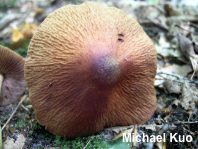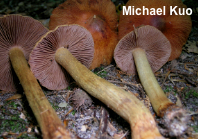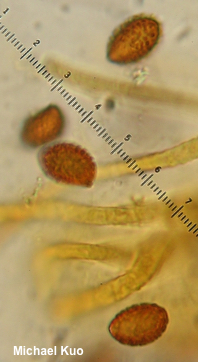| Major Groups > Gilled Mushrooms > Dark-Spored > Cortinarius > Cortinarius corrugatus |

|
Cortinarius corrugatus [Basidiomycota > Agaricales > Cortinariaceae > Cortinarius ... ] by Michael Kuo If it weren't for the distinctively corrugated cap—reminiscent of the cap of Psathyrella delineata—this mushroom would be a nightmare to identify. Most authors have placed it in the traditional (but now out of fashion) subgenus Bulbopodium of Cortinarius, but the crucial features for Bulbopodium were a slimy cap and a stem that ended in an abrupt basal bulb; Cortinarius corrugatus is likely to meet this description only when it is about two centimeters high, since the cap often dries out and the stem elongates quickly, so that by maturity the bulb is not much of a bulb. Aside from the corrugated cap, salient features include the faintly lilac, then rusty gills; the rusty brown spore print; the long and slender stem that by maturity features only a slightly swollen base and usually lacks a ring zone; the terrestrial growth under hardwoods (especially beech) in eastern North America; and the large, warty spores. Description: Ecology: Mycorrhizal with beech and other hardwoods; growing alone, scattered, or gregariously; summer and fall; widely distributed in eastern North America, and reported from Costa Rica. The illustrated and described collection is from Michigan. Cap: 4–8 cm; bell-shaped to convex or widely conical at first, becoming broadly convex to broadly bell-shaped; sticky when fresh or wet, but soon dry; bald, but distinctively corrugated-wrinkled except in the very center; orange-brown to reddish brown or yellowish brown. Gills: Attached to the stem by a notch; close or nearly distant; very pale lilac at first, becoming cinnamon to rusty with a slight hint of lilac; cortina ephemeral. Stem: 7–13 cm long; 1–1.5 cm thick; more or less equal, terminating in a slight bulb; dry; finely silky; whitish to yellowish or pale brownish. Flesh: Whitish; unchanging when sliced. Odor: Foul or spermatic. Chemical Reactions: KOH on cap surface dark red to black. Spore Print: Rusty brown. Microscopic Features: Spores 12–15 x 8–10 µm; amygdaliform; moderately to strongly verrucose. Basidia 4-sterigmate. Hymenial cystidia not found; marginal cells present, clavate to subclavate. Pileipellis a slightly gelatinized cutis of ochraceous to orangish, encrusted elements 2.5–5 µm wide. REFERENCES: Peck, 1872. (Saccardo, 1887; Kauffman, 1918; Kauffman, 1932; Smith, Smith & Weber, 1979; Phillips, 1991/2005; Barron, 1999; Roody, 2003; Halling & Mueller, 2005; Miller & Miller, 2006; Binion et al., 2008; Kuo & Methven, 2014; Baroni, 2017; Elliott & Stephenson, 2018; Sturgeon, 2018.) Herb. Kuo 09110503. This site contains no information about the edibility or toxicity of mushrooms. |
© MushroomExpert.Com |
|
Cite this page as: Kuo, M. (2020, July). Cortinarius corrugatus. Retrieved from the MushroomExpert.Com Web site: http://www.mushroomexpert.com/cortinarius_corrugatus.html |


